Black locust is a fascinating tree. Today I'll share a quick description of black locust trees in general, some pros and cons to consider of their spreading, as well as how I harvest and cook with their delicious white flower clusters that are, without a doubt, the best edible flower I've ever had.
Besides the commonly eaten flowers pictured in this post, bristly locust *(Robinia hispida) are also edible, and pink!
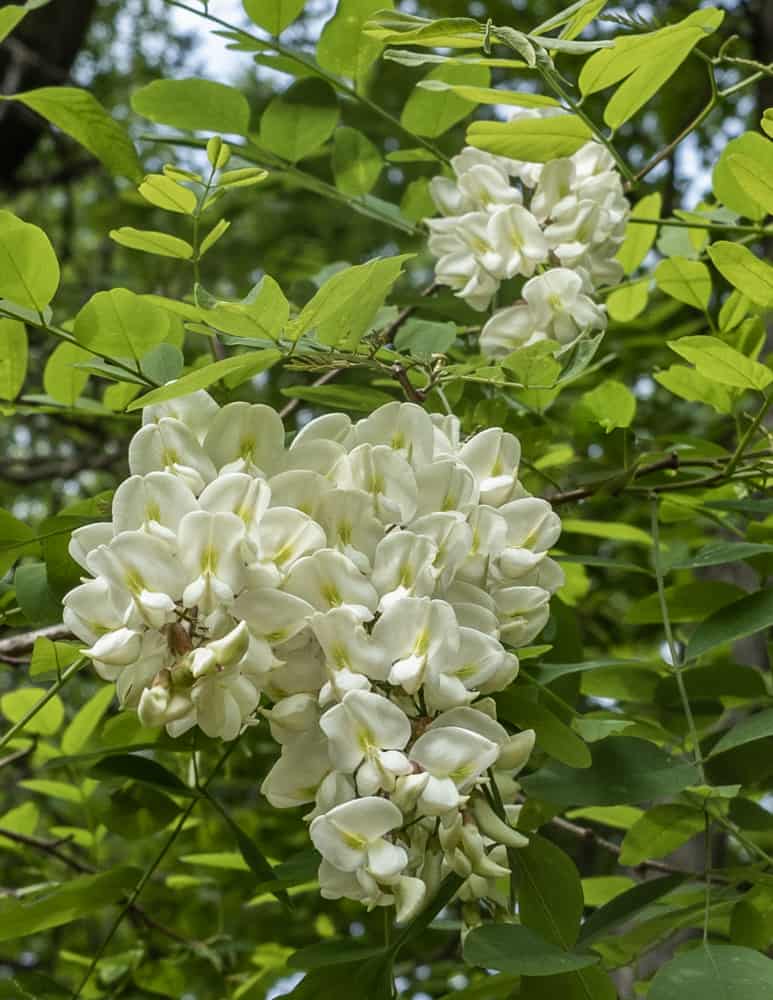
Black Locust Tree Identification
Black locust (Robinia pseudoacacia, also known as false acacia or yellow locust) are often large trees.
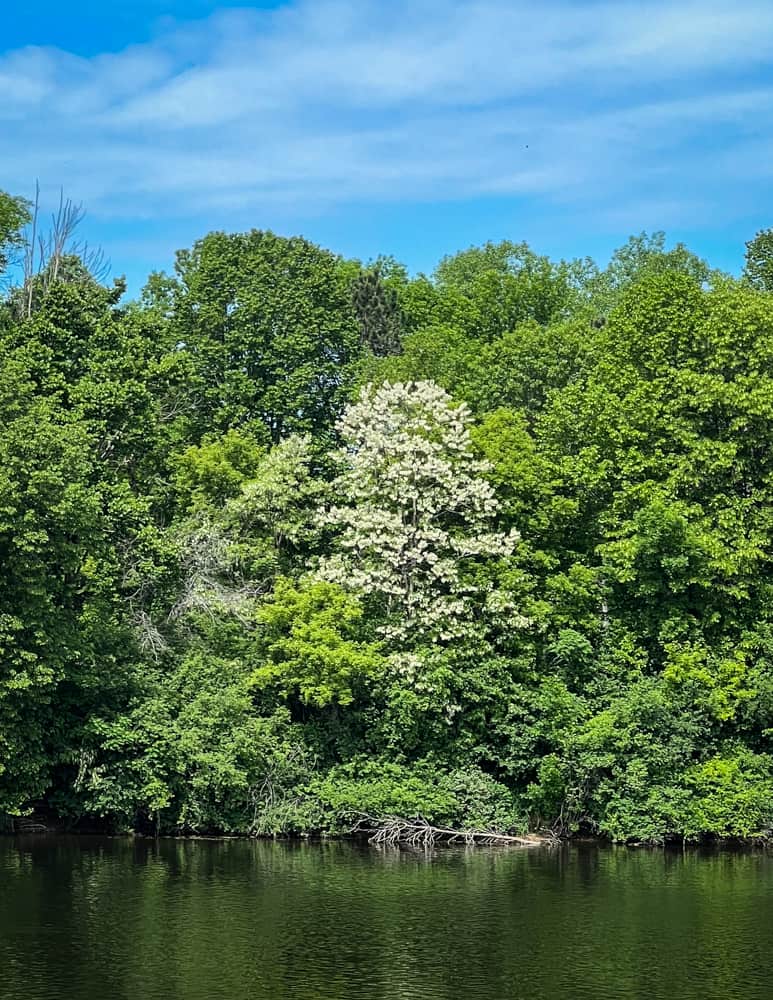
Once you get to know them they're easy to spot at a distance with their irregular crowns, and grooved, scaly bark. Young trees often have long, prickly briars on the trunk, as well as smaller ones on the young branches.
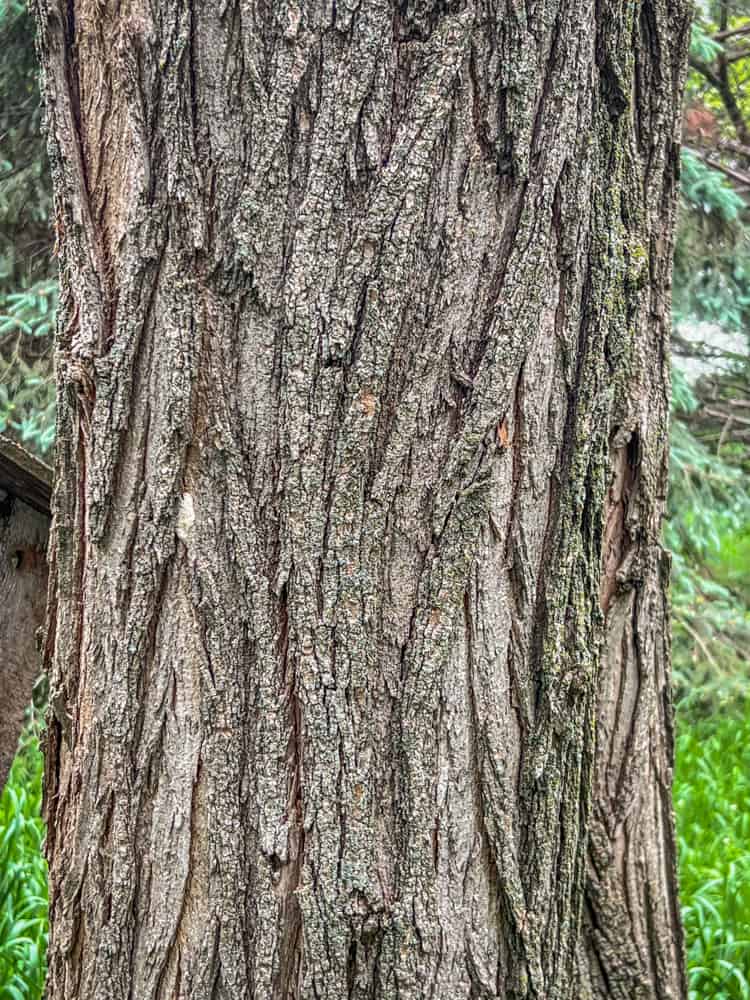
During late spring and early summer they can produce incredible amounts of flowers that eventually produce flattened, leguminous pods that look like tiny snow peas. The seeds inside the pod are edible, but tiny and hardly worth gathering in my opinion.
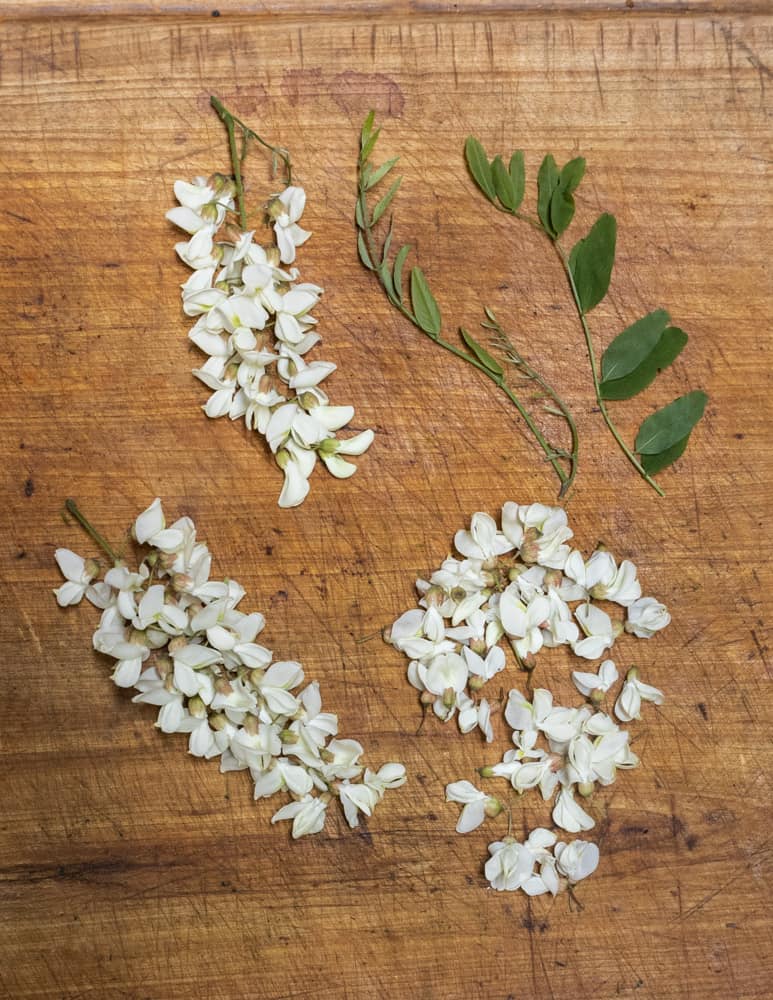
An invasive with potential?
Black locust is seen as an invasive tree or a trash tree in a lot of places, but the tree also has some uses. One thing that's been interesting to read about is the invasive status of black locust in North America.
In most of the states I know It's thought of as invasive, even in it's native range in some places, but I found a useful article by Maureen Sundberg comparing black locust to the American chestnut tree invading maple, ash and birch forests after the glaciers receded.
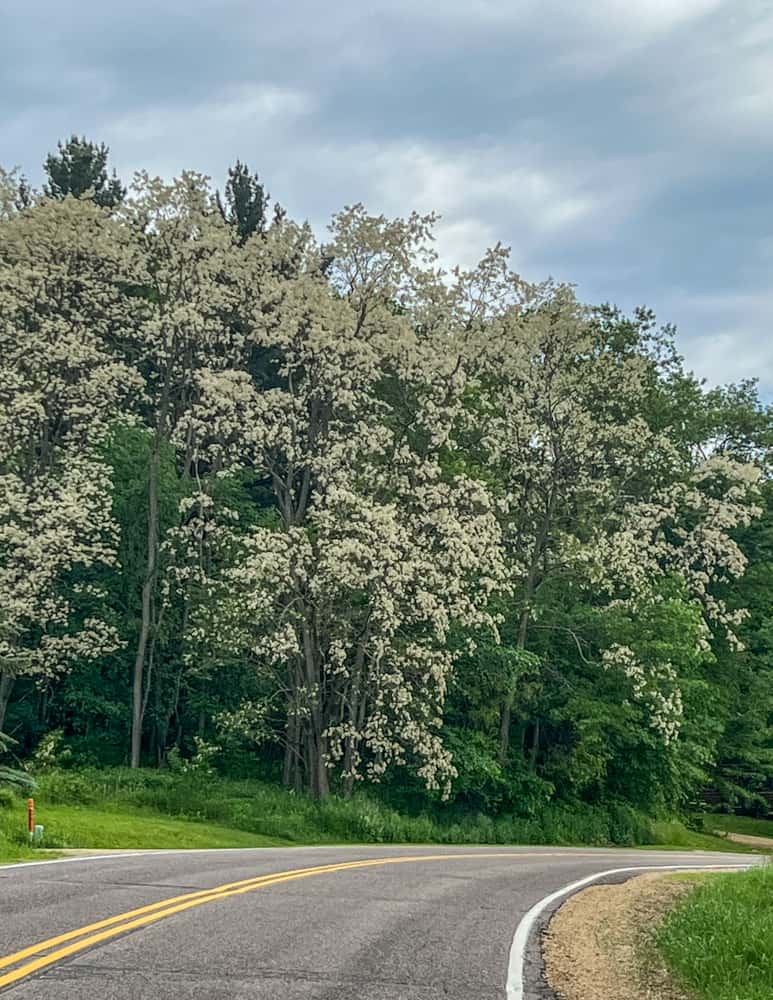
Sundberg mentions that Although black locust spreads through woods quickly, it also hosts 67 species of Lepidoptera (butterflies and moths). There's a link to the article at the bottom of the post.
Black locust is a fabaceous tree in the legume family, which means that it's a nitrogen fixer, increasing the amount of nitrogen in the soil where it grows. This might sound good, but enriching soils that are low in nitrogen (nitrogen fixing can be helpful in soils not low in nitrogen) can also pave the way for more invasive species to grow in the understory below the trees.
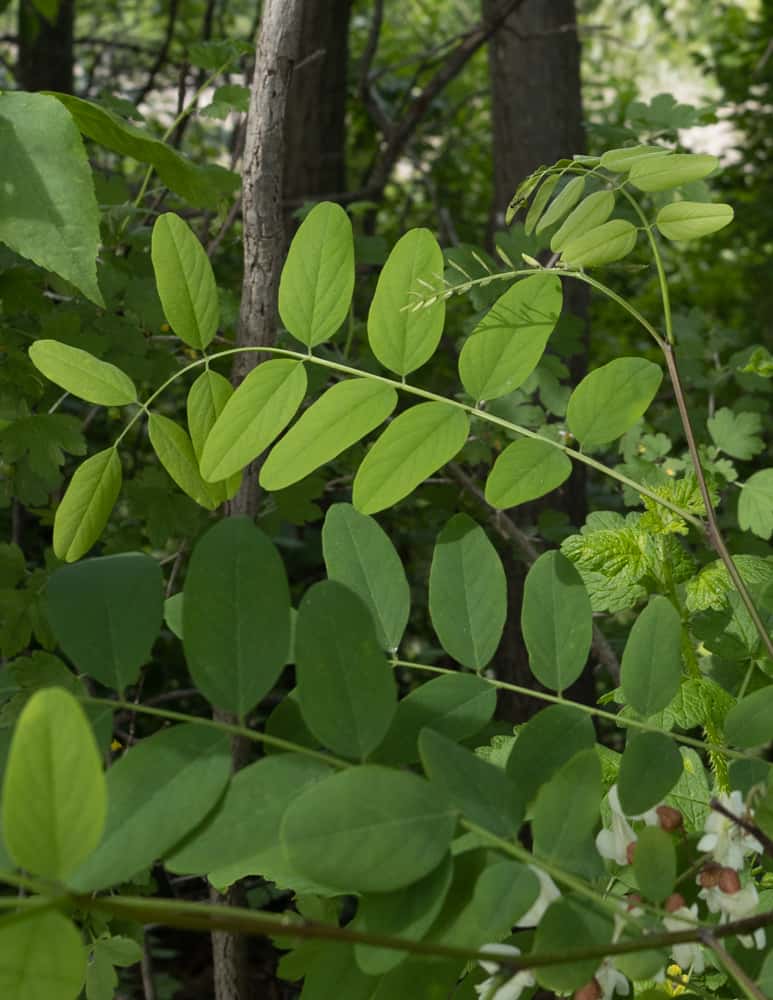
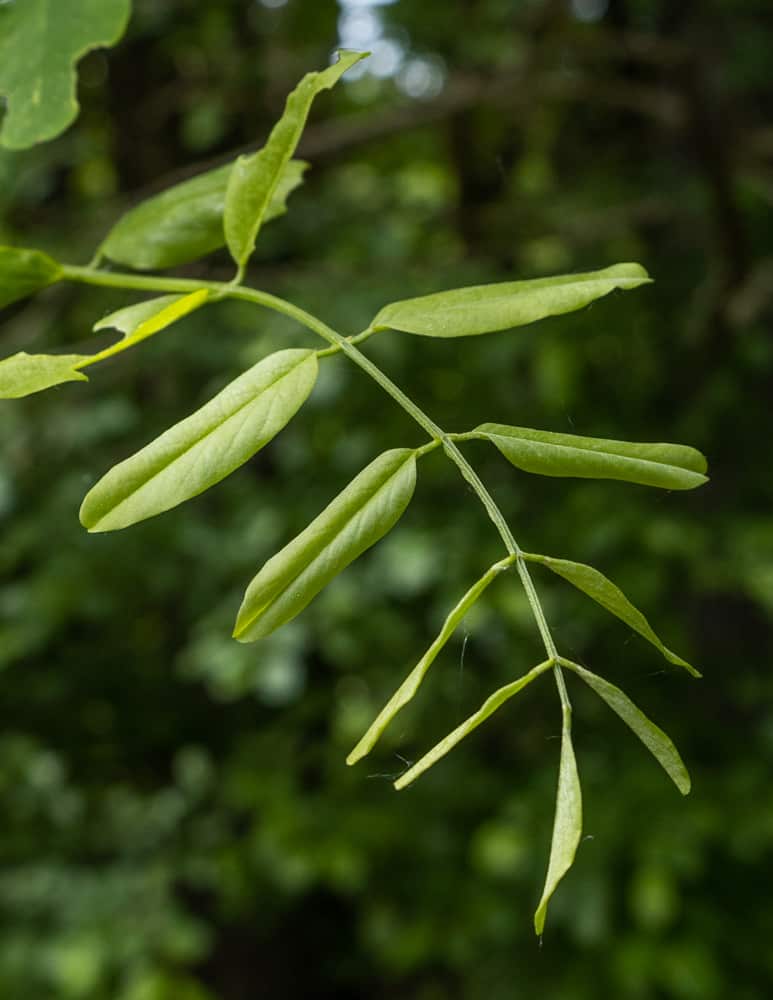
No matter how you look at the tree, it's vigorous growth and root suckering means it has the potential to change landscapes. I'd prefer if the trees stay out of the oak savannahs near me, since if the oaks go, all the wild mushrooms that grow with them will go too.
Black locust wood uses
My lumberjack friend Zach of Foxwalk Sawmill is milling some locust for my deck. I spoke with him about it and was surprised to hear him talk at length about the commercial value of black locust wood. Producers seem scarce, but Zach says he uses a good amount of it, pricing it at a premium comparable to Brazilian hardwoods.
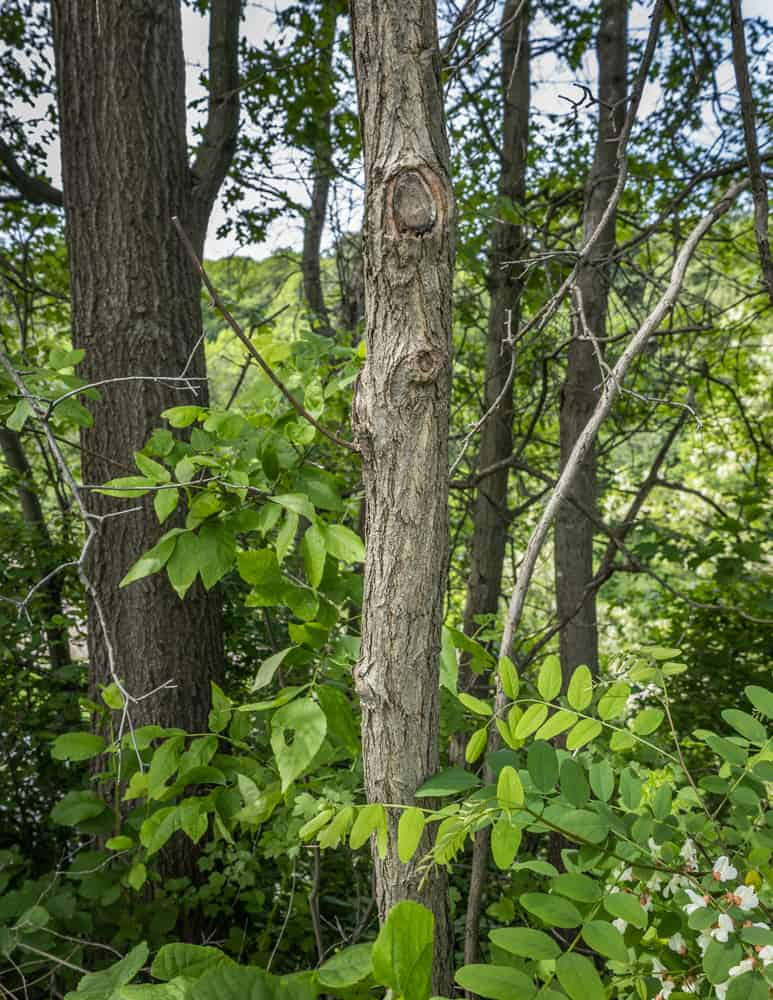
Black locust wood is extremely rot resistant, so Zach uses it as a substitute for treated wood. Cutting black locust down and selling the wood at a high price seems like one of the best uses of an invasive I know of. You can't build a deck from Japanese knotweed!
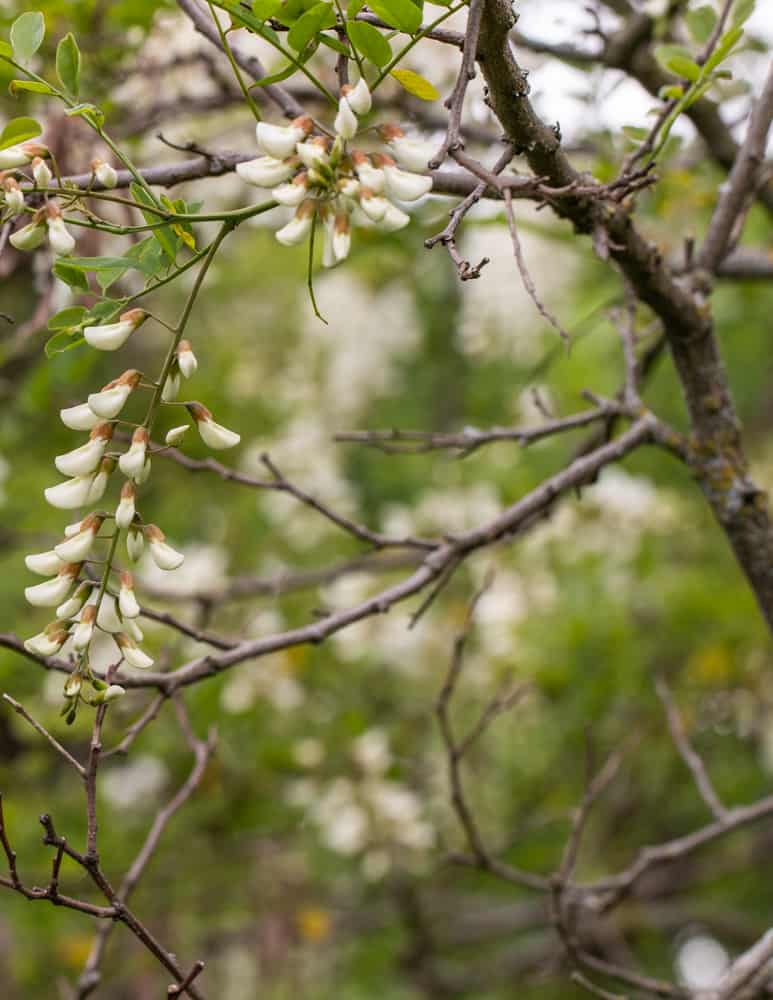
Flowers
Finally, the flowers. Black locust blossoms are my all-time favorite edible flower, and if you haven't tried them you're missing out. They're enjoyed and well-known in the wild food community and during late May and June my social media is usually filled with people eating them.
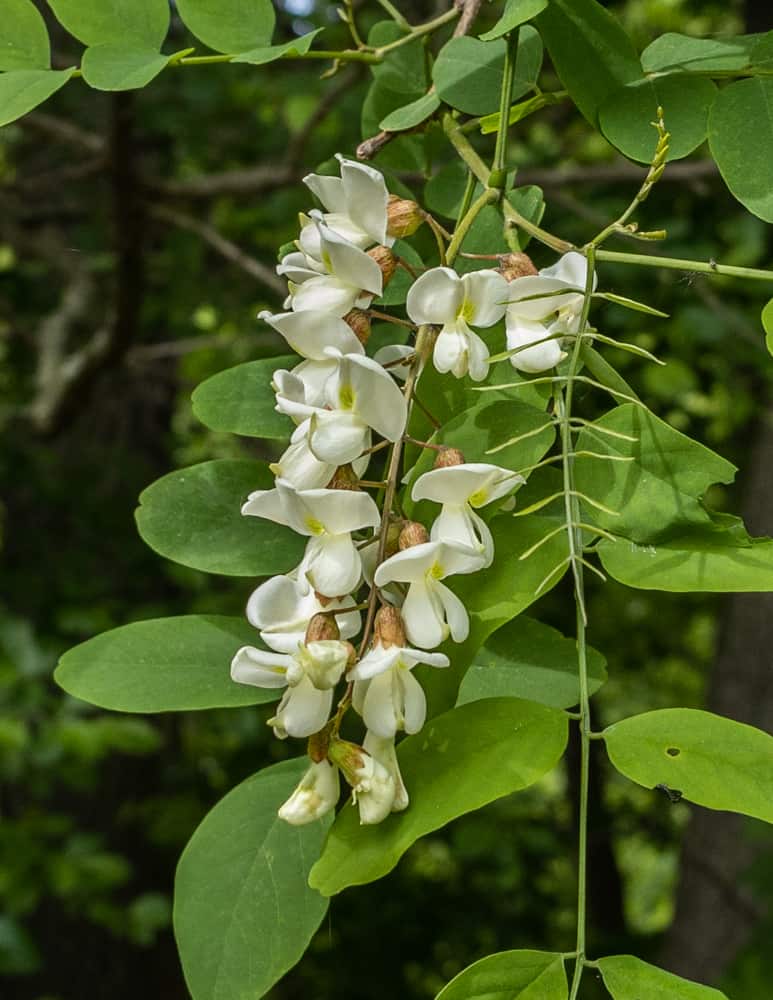
Since they're a legume, the flavor of the flowers is slightly reminiscent of peas, but with an intense, sweet aroma that reminds. The smell of the blossoms is often compared to vanilla, but I think jasmine is more accurate. At peak season I can smell the perfume from a distance before I even reach the tree, and it's intoxicating.
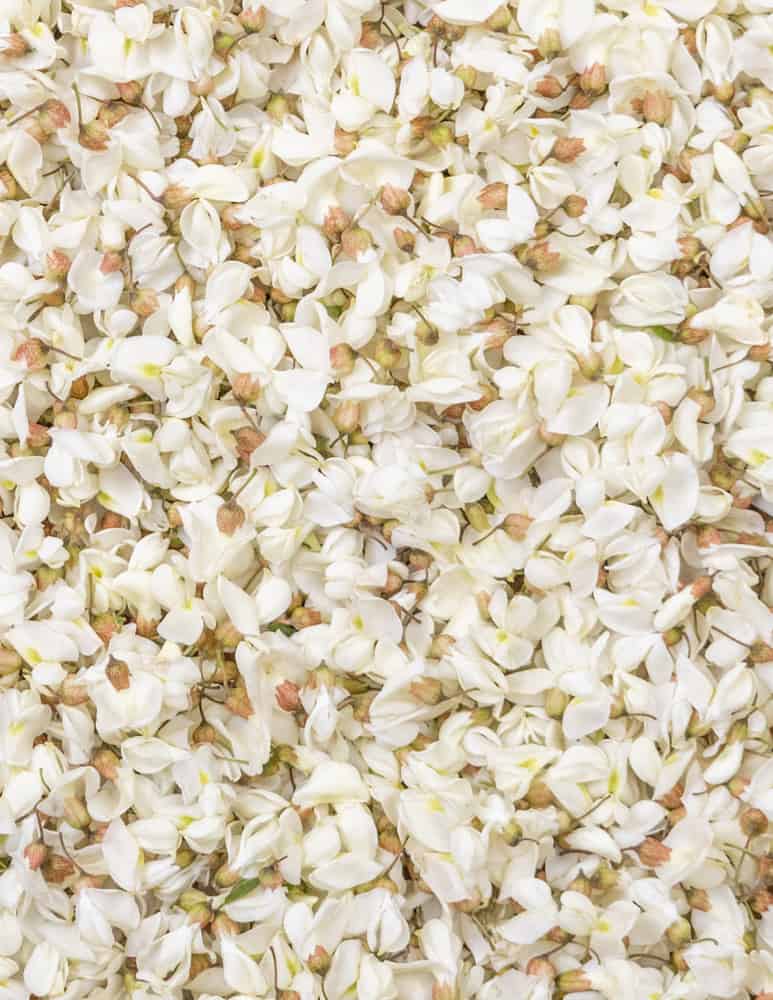
Harvesting Black Locust Flowers
To get the flowers you have to move quickly. I've heard some people say the window for harvesting is up to two weeks, but I disagree. At first glance, some branches full of aromatic white blooms may look good, but if they've been on the tree for too long, the flowers can be dried out and discolored, lacking in flavor and wilted.
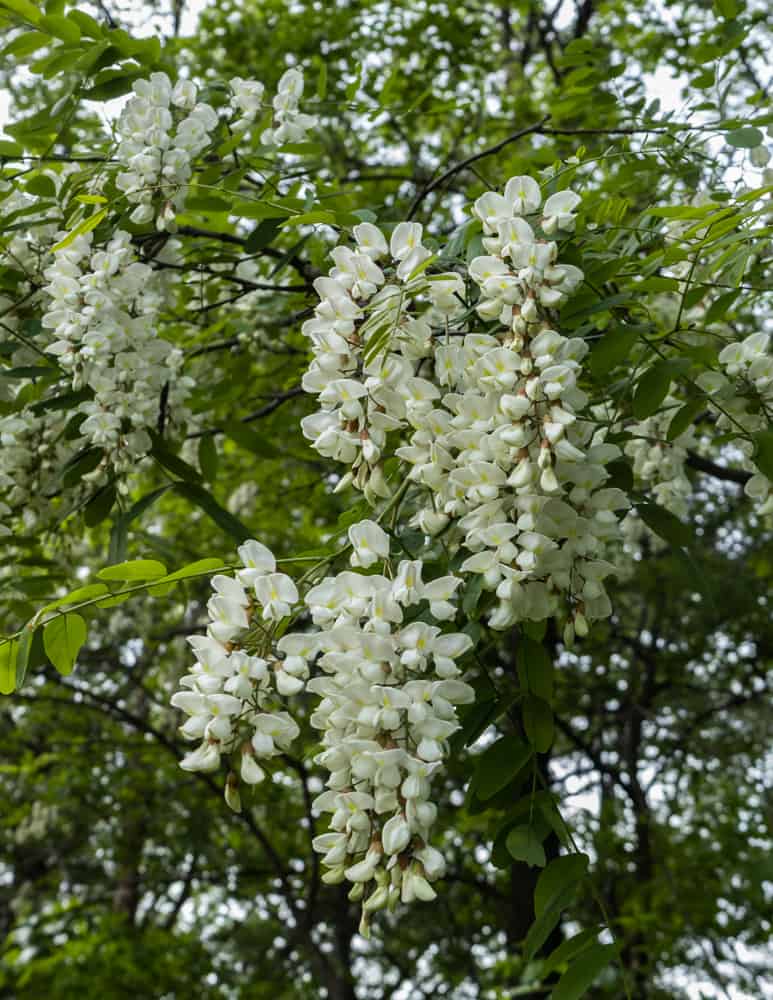
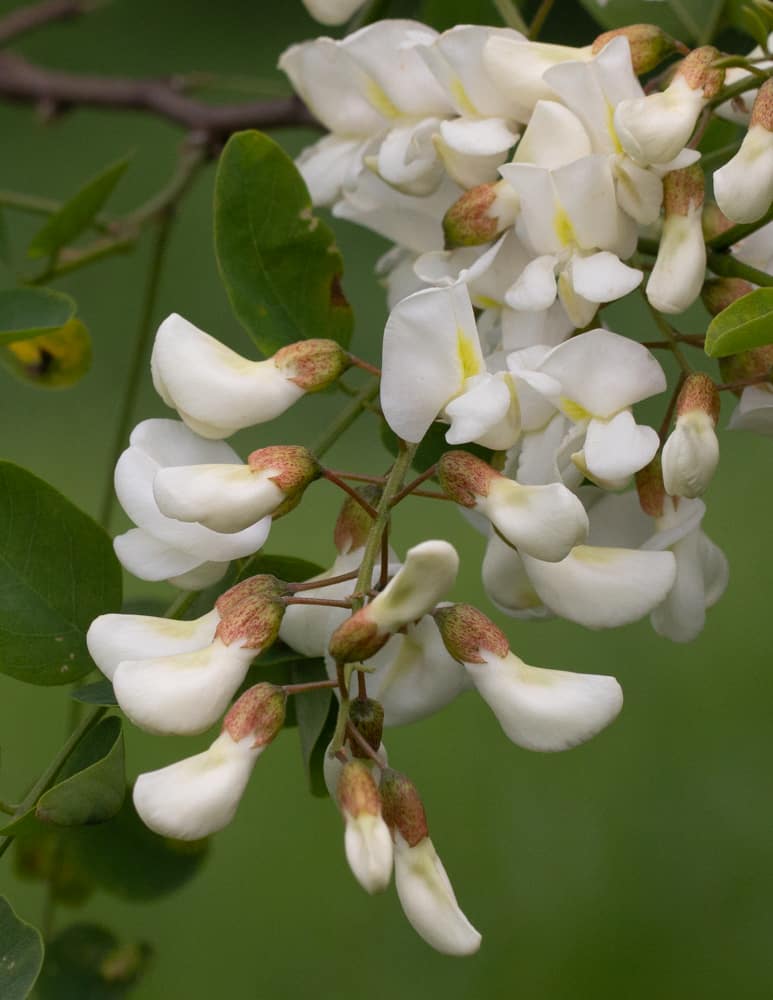
You're looking for pristine white flowers with a strong aroma. young, unopened flowers are edible but not ideal. Harvest your flowers on a dry day as rain can compromise them.
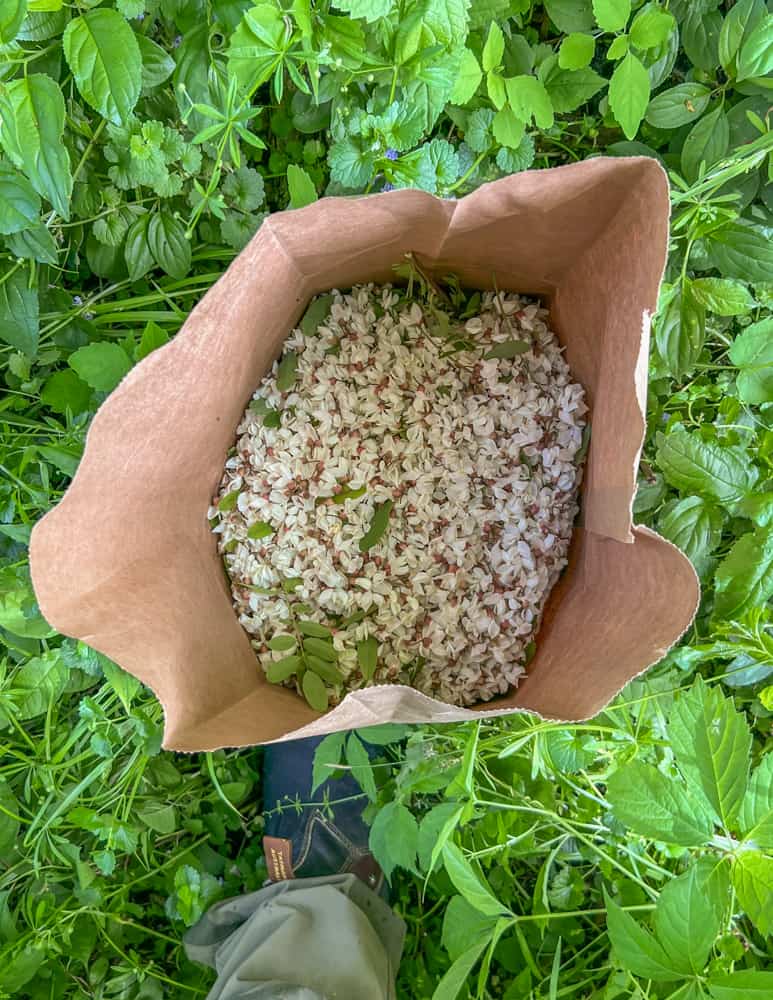
Harvesting the flowers is easy. The difficult part is finding low-hanging branches that you can reach. I've found two types of hunting that work well for me. The first is looking for trees on the edges of woods that have low branches. The second, and the most efficient is finding young colonies of trees that aren't much taller than me.
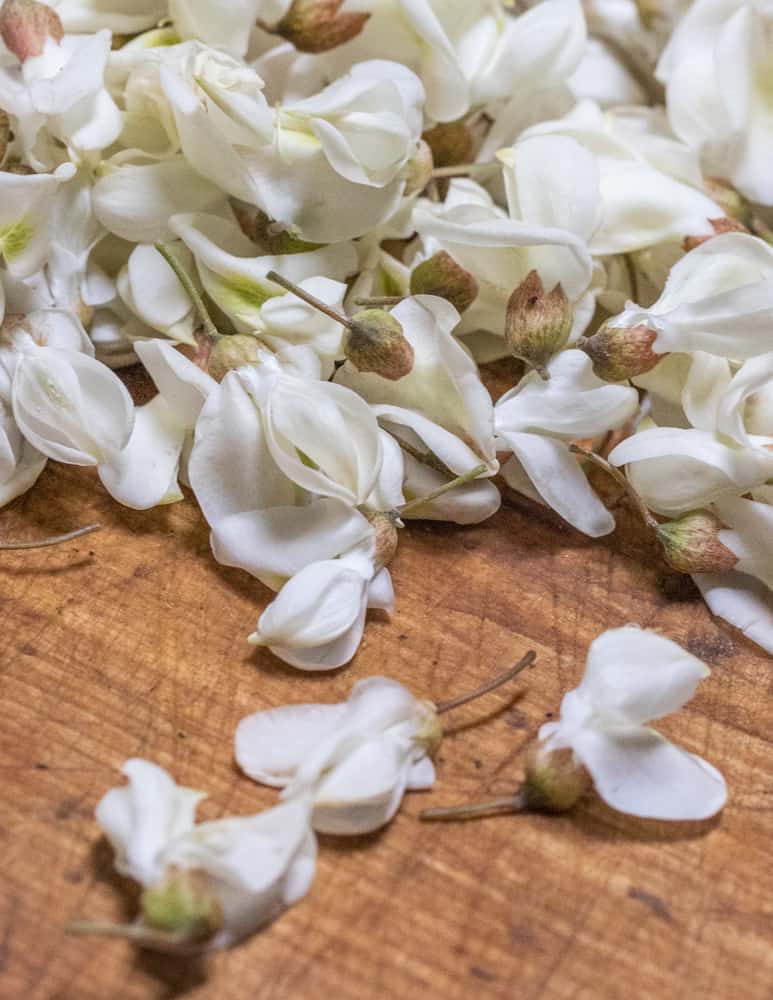
Getting branches that are out of reach
If branches are just out of reach, I'll unravel a coat hanger and use the hook to gently lower the branches. To harvest, I grasp the branch with one hand, and strip the flowers from it with the other. Inevitably you'll get some leaves mixed in, which you'll want to remove as they're not palatable. In a good patch, I can easily harvest multiple gallons of flowers in twenty to thirty minutes.
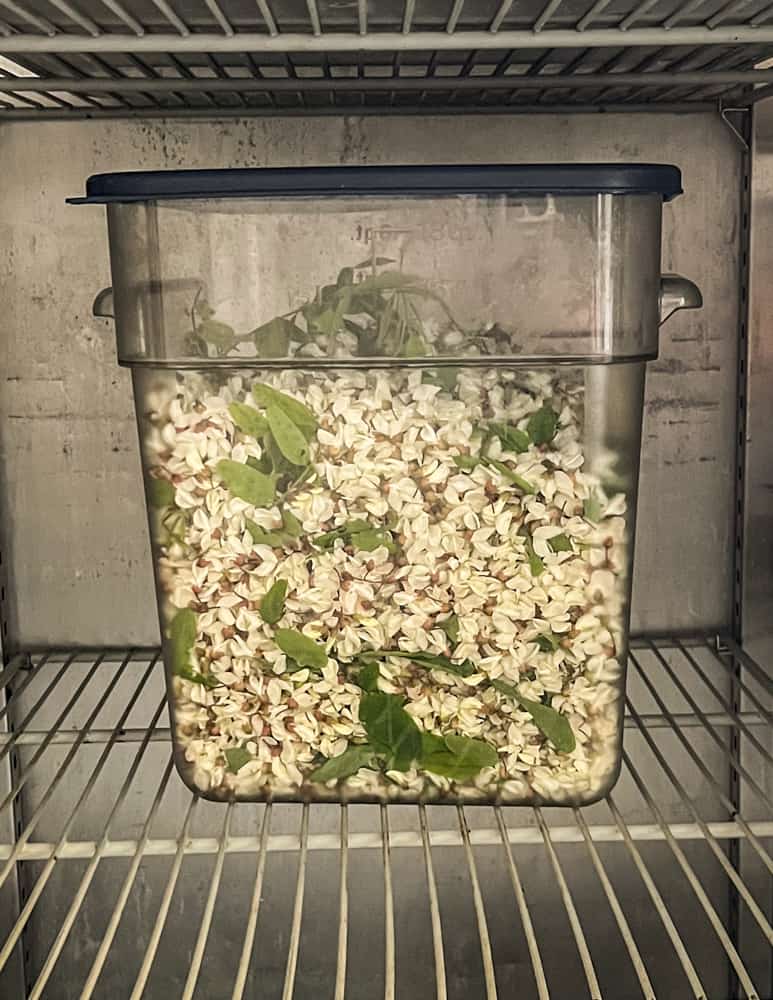
After I pick them from the tree, I cool down the flowers as fast as possible, storing them in a container with hard sides to prevent them from being crushed. It's ok to harvest them in a paper bag, but you'll want to put them in a plastic container or at least a zip-top bag in the refrigerator to prevent them from drying out.
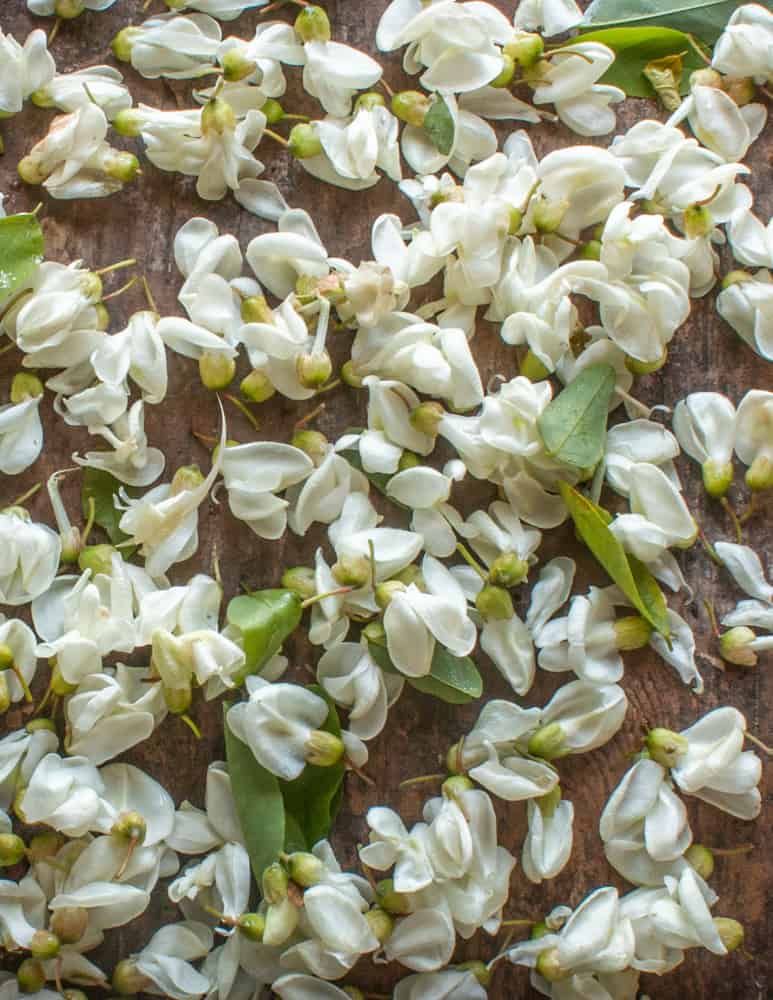
When you bring the flowers home, spread them out and inspect the blooms before eating for insects. Other than that they don't need any special treatment. There’s no need to wash the flowers, and doing so can waterlog them, robbing them of their sweet nectar and perfume.
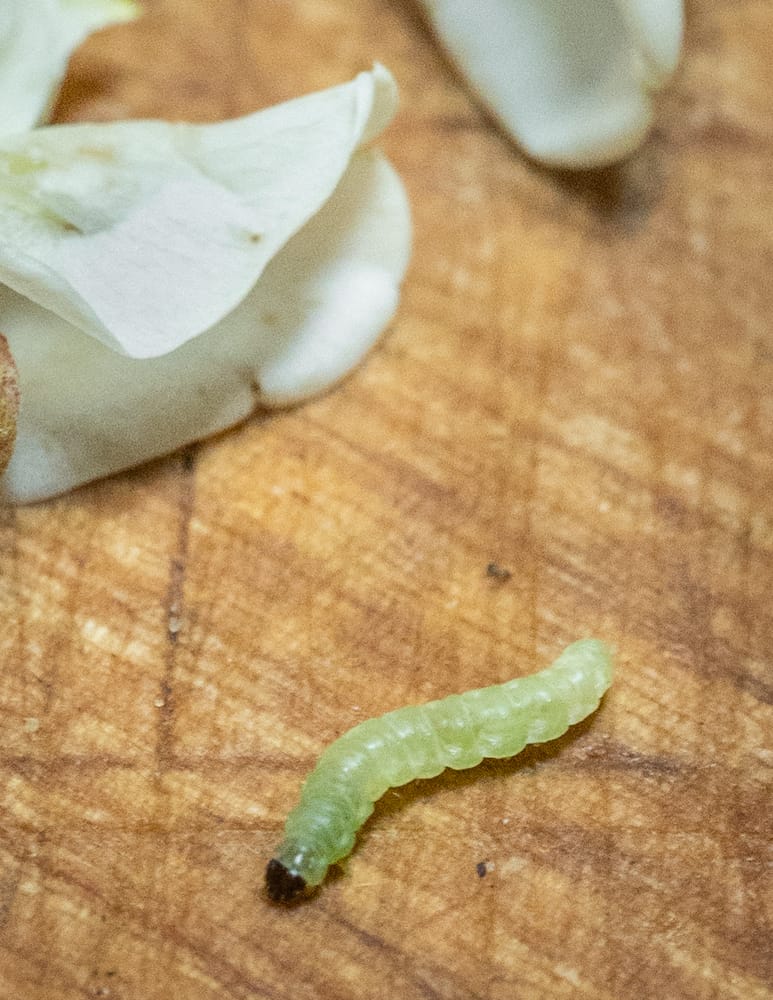
Cooking Black Locust Flowers
Most of the time when I see people cooking with black locust flowers it's in the form of flower jelly or deep-fried blossom fritters. To me, both of those are a waste of food. I bread and fry plenty of things, but flowers are delicate and deserve a light touch. It's also hard to make fried batter and sugar taste bad.
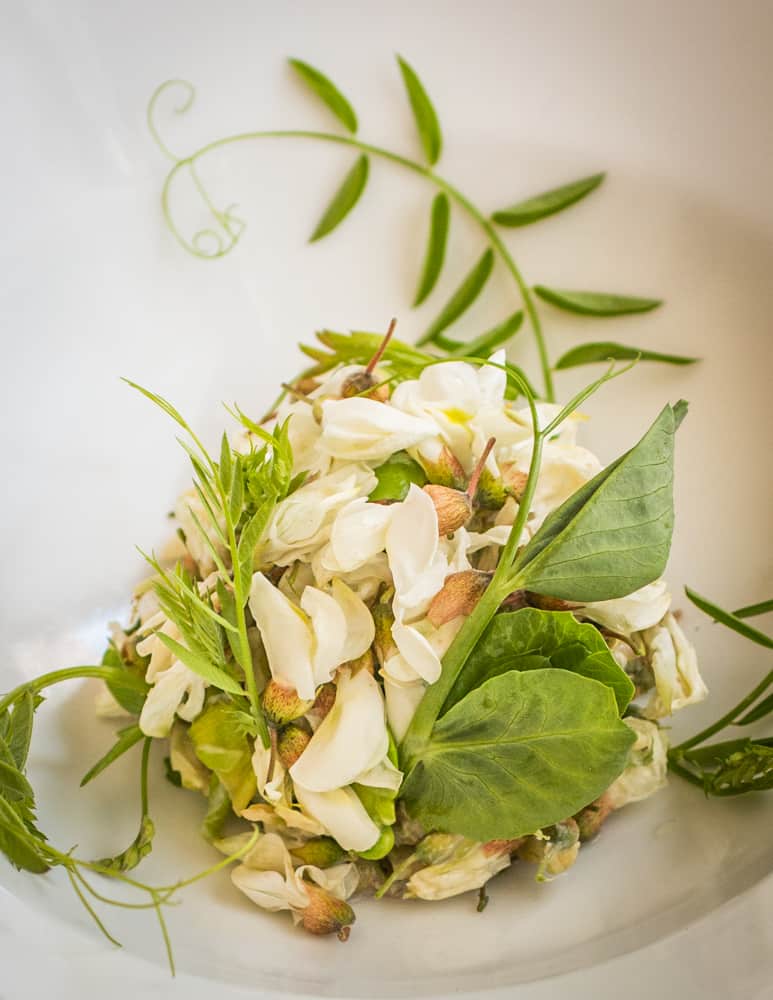
Until a few years ago, I mostly used the flowers as a garnish. That changed when Samuel Thayer described a black locust flower recipe to me that was not only delicious, but completely changed how I consider the plants as an ingredient. If you take nothing else from this post, it should be the lesson hidden in Sam's locust salad.
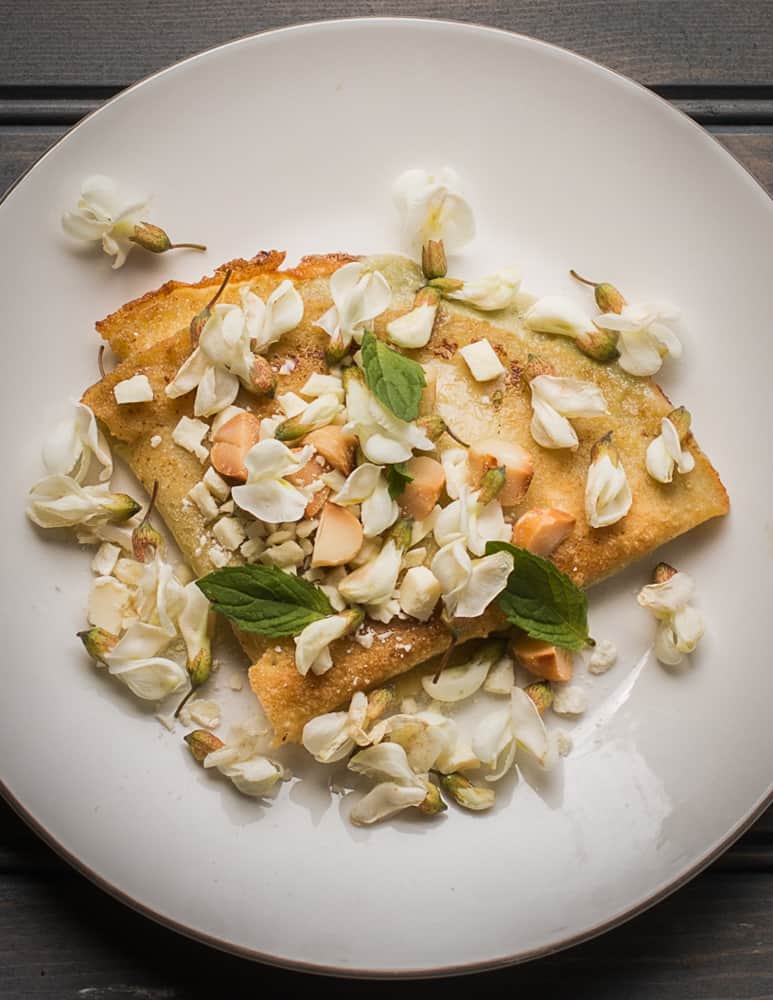
Sam takes a large amount of black locust flowers, cooking about ⅓ of them quickly in coconut oil until wilted. Off the heat, he stirs in another ⅓. After the mixture is cooled, he stirs in more fresh flowers, along with sweet corn.
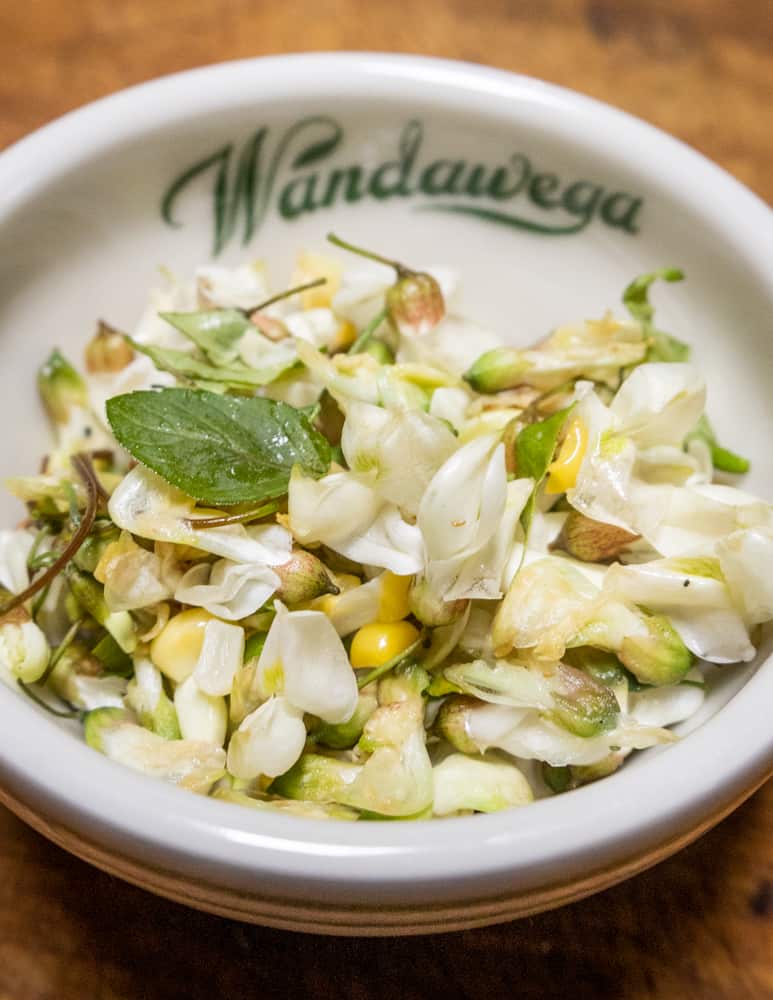
I've cooked a lot of things, but never in my life had I considered cooking the flowers as a vegetable. The thing is, it actually makes sense to cook them since they're the only flower I know of that can not only be harvested in large quantities, but also tastes mild enough to eat in an amount comparable to another vegetable. It was nothing short of genius.
Preservation
Besides stuffing your face with handful after handful and upping your salad game, black locust flowers can also be dried for tea and infusions. The dried flowers aren't as intense as fresh, but they can be added to tea blends and make an interesting dessert infused into dairy.
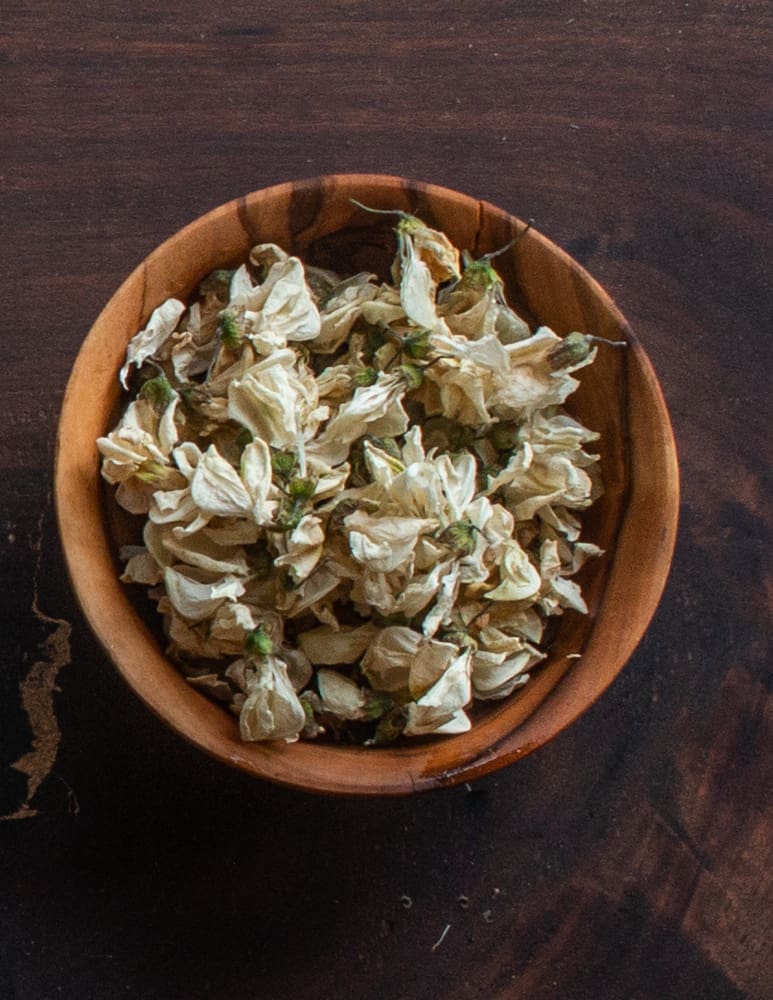

Gerr
I loved this post! Black locust flowers are so beautiful and unique. I can’t wait to try the recipes you’ve shared—especially the tempura! It’s great to see such creative ways to use foraged ingredients. Thank you for the inspiration!
Allison
Would these flowers make a good simple syrup, like elderflowers?
Alan Bergo
Yes I infuse them cold in water overnight, strain, add sugar and mix to dissolve.
Carla Beaudet
All I did with the blossoms this year was toss some on a stir-fry along with sliced spring onions. It was good, but I heard a "woah!" from the kitchen when my husband was serving his plate; a couple of those little green worms were crawling out to escape the heat! The aroma of the woods when those trees are blooming is downright magical. I was thinking there was some recipe I really needed to try, but had forgotten what it was, and did not look up this post in time to try Sam's salad recipe. Just left myself a note to try it next year. Black locust is one of the predominant hardwoods on our land. Shagbark Hickory, Black Cherry, and Sugar Maple too. Sadly, it's only bout 25% forested, and we have to mow the remainder to keep the invasive species at bay.
Alan Bergo
Hey Carla. Oh yeah, flowers are attractive to a lot more than humans! 🙂 My favorite story is the baby snake I found in a hen of the woods.
Barbara Fisher
This is the first year I've noticed such a large amount of blossoms.... how often do they bloom?
Alan Bergo
They bloom every year.
bren
hey Alan, just wondering if you knew whether or not Honey Locust flowers are also edible?
Alan Bergo
I can't, I haven't eaten them and I don't think they're as gregarious as BL. If you find something out about them let me know, they're everywhere in St. Paul.
Craig
Oh yes, great idea. I'm a huge fan of Black Locust flowers, and we have an ever-increasing abundance of the trees here in our little Colorado town. I harvested 5 gallons, infused them in hot water, and added honey and cane sugar, and yeast (and a little yeast nutrient) and made a sort of Mead/Black Locust Flower wine. It was amazing, but NOT the point of this experiment. I further fermented it into Black Locust Flower Vinegar. My Vinegar didn't finish out as high in acidity (2.8%, and pH 3.3) but it'll make a great vinaigrette I'm certain. Super fun! I'm a distiller, and I plan to do a small batch of an infused Gin or Vodka next year in our tasting room. Yes, I know I'm late to the party...
Petra
Where can I find recipe for those black locust filled crepes please?
Alan Bergo
I haven't published it yet. The editors pulled it from my manuscript. You also need to have a highspeed blender. If you want I can send it to you via email. alanbergo3 AT gmail.com
Amanda Goodmanson
I would love this recipe as well 🙃
Melanie Drecksel
My grandparents used black locust for fence posts because they don't rot quickly. They must have used most of the trees because we rarely saw a live tree 🙂 I'm surprised to hear that it is an invasive species. Would love to try this, but I live on the west coast now.
Erik
Do you know if the shrubbier, pink flowered, SW species like Robinia hispida and R. neomexicana also have edible flowers. IfI were both younger and had lots of land (and lived in an area where locust borers didn't ruin the lumber), I might consider managing black locust for timber, but if realistically the flowers are the only crop, I'd want them lower and easier to harvest. The shorter western species seem to offer that opportunity.
Alan Bergo
I'm not familiar with them.
Wanitaya Newberry
I found that pink black locust flowers are edible too.
Alan Bergo
Yes I just ate some bristly locust yesterday.
Fay
Thanks for this. I can’t wait to try it next year. For this year, I’ll have to be satisfied with my black locust honey, one of the favorites my bees bring in each year.
Alan Bergo
That's a great honey
Jacqui
One of our seasonal favourites is "fruit and flower salad" of about half and half sliced fresh strawberries and Robinia flowers. very simple, very complementary, very good.
Blair Miller
I found an enormous stand of them on my way to a local cabinet shop to get a quote on some new doors. Anyway, I went back the next day and filled a paper grocery bag in about 45 minutes. I haven't had a chance to post any of these yet, but I ended up making wine, fermented cordial, vodka and gin infusions, "crepes" (my crepe game is vv weak—this are more like pancakes), and two vacuum bags of fermented flowers (one w/ salt, one w/ sugar—the instructions I have say they need to sit for a year, so we'll see). I'll also dry and powder the flowers (along w/ sugar) from the cordial once it's ready—I use it to rim cocktail glasses occasionally. I'll have to give Sam's salad a go next year—the flowers came and went in less than two weeks here.
Alan Bergo
That all sounds awesome Blair. I need to try some pancakes with mine.
Wanant, Wanida
Try omelette, so delicious. Especially Thai style. I also cooked Thai sour soup.
Alan Bergo
Good idea
carolita
How would you dry them to save for tea? Air dry or dehydrator? I’ve got tons!
Alan Bergo
Dehydrator on low
Hannah Helm
I am so bummed. Our black locust season here in KY has been over for almost a month. I did harvest some and made a flavored vinegar, but can't wait to try as a vegetable. They don't appear to be invasive here. As a previous commenter said, they tend to be a pioneer species that prefers edges. I'll have to try the coat hanger trick. I always enjoy what I learn from you.
Don Blackert
Alan: Great post. I've never tried them but certainly will. Barely past the season here in SW Pennsylvania. I'm not sure if they are native here but they sure "act like it". Here are a coupe additional thoughts on the species. First, they are definitely rot resistant. I bought my farm 32 years ago and the place was fenced entirely with Black Locust posts that the original installer said were put in 45 years before I got here. Many have rotted but I'd guess about 50 to 75% are still solid usable fence posts. Milled they make "around the farm" lumber that never rots. Additionally, the only wood I know of i this area with higher heat value is Hickory (and Osage Orange.
One other thought, which is how I intend to harvest the flowers next year, is to simply cut the tree down at peak season. Around here people allow patches of them to grow close together so they grow tall and straight quickly without branching out to quickly. That way they make nice straight, branch (knot) free fence posts or lumber. If they are considered to be invasive why not cut them during peak flower season, cut the stems into firewood, and easily harvest the flowers.
And yet another thought - My property has sections of very old growth oak (white, red and chestnut oak) along with hickory, cherry, walnut and maple as the main species. I have never seen Locust invading those tree stands. They are always on the outer edges or grow as a pioneer species in disturbed areas or fields left to go fallow.
They also are prone to being "preyed on" by a fungus known as "artist conk". Wonderful little inedible fungus that is nearly rock hard on top but the underside is soft-ish and carvable or can be used for a variety of vey permanent artworks.
Dean Sherwood
I can attest to the fact that they make lousy firewood. Locust burns quickly without a lot of heat.
Alan Bergo
Thanks Dean. I just had my whole front porch replaced with black locust and it's really nice.
Terry
Thanks Alan for these weekly educations to more widely appreciate the world around us. I love learning something new and tasty nearly every week! As a ecosystem and landscape consultant here in the West, I would like to request that the title of the link "Nitrogen Fixing Plants Pave the Way for Other Invasives" be changed somehow to reflect that this is true only in naturally nitrogen poor ecosystems, lest your readers infer that all nitrogen fixing species are bad. This sentiment is already often expressed by clients in my work. Nitrogen fixing species are both involved in succession and maintenance of many native ecosystems. And there are an increasing number of farms worldwide that are reducing the need for inputs of fertilizers due to the proper placement and choice of nitrogen fixing plants, even black locust in carefully considered applications. Am looking forward to the black locust bloom this year, not only for the native bees, but also for us to try!
Alan Bergo
Thanks Terry, yes I'm aware of that, and it's a good clarification. My goal here is to bring up some of both the good and potentially negative aspects of the tree-some of them need more unpacking than others.
Laura
They are also delicious fermented into a kombucha-style drink!
Atina
THANK YOU! I so appreciate the detail and depth of your posts, the history of the plant, their impact on other plants and the environment, and of course ideas on how to prepare as food. Thank you for your generosity in sharing your passion. Thank you.
Alan Bergo
Thanks Atina. When I do these more in depth profiles they're often made up of images and experience I sit on for years until I feel like they're worth sharing, so that means a lot to me.